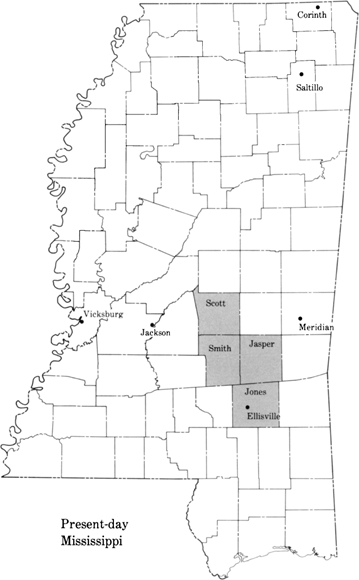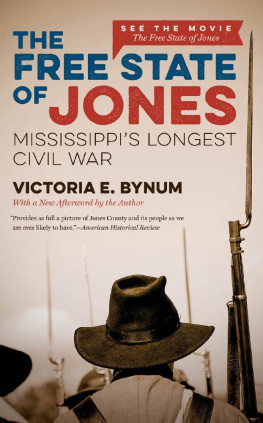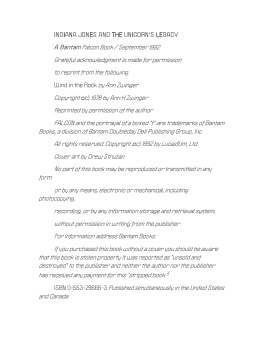Legend of the
Free State of Jones

Legend of the
Free State of Jones
by
RUDY H. LEVERETT

Copyright 1984 by the
University Press of Mississippi
All rights reserved
Manufactured in the United States of America
Library of Congress Cataloging in Publication Data
Leverett, Rudy H.
Legend of the free state of Jones.
Includes bibliographical references and index.
1. Jones County (Miss.)History. 2. Mississippi
HistoryCivil War, 18611865. 3. Secession. I. Title.
F347.J6L48 1984 976.255 84-7513
ISBN 0-60473-571-6
Contents
Preface
History is the attempt to record and explain facts about events and ideas of the past. Such attempts succeed in being history only to the extent that they succeed in being true. Legends, on the other hand, are stories which have been handed down from earlier times and that many people regard as being, in some sense, true. If such stories were known to be true, of course, they would not be called legends, but history. But without any aura of truth hovering about them, they would equally fail to qualify as legends and fall into some other category such as folk tale, fable, or myth. Historical ambiguity, then, is an essential aspect of what we mean by the word legend. To say that historical uncertainty is characteristic of legends is not to say that legends are merely bad history; they are not history at all, but a form of literature that usually has some, perhaps indeterminate, relationship to historical events and people. It makes no sense, therefore, to speak of disproving, refuting, or debunking a legend. Since the truth of a legend is not to be found among the empirical facts of history, there is no record to be set straight. Nevertheless, it is important to mark differences between legend and history when, so to speak, they overlap. When the former is mistakenly treated as the latter, when legendary characters and events are confused with the events and characters of history, the result is neither history nor literature, but only falsehood. For this reason, it is not the purpose of this book to impugn the legend of the Republic of Jones, but only to reveal as clearly as possible the historical events and circumstances which relate to it.
Whatever merit this work may have is due in large measure to the generous assistance I have received over the years from the professional librarians and archivists of the Lauren Rogers Memorial Library in Laurel, Mississippi; the Jones County Junior College Library in Ellisville; the Mississippi Department of Archives and History in Jackson; and the National Archives in Washington, D.C. The faults of the work are, of course, my own.
Chronology
1830: The Treaty of Dancing Rabbit Creek opened new land for settlement to the northwest of Jones County and precipitated an exodus of the population of the county to these new lands. Newton Knight was born on 10 November of this year. The lapse of civil government in Jones County is believed to date from about this time.
1841: J. F. H. Claiborne visited Jones County.
1843: On 18 July the Mississippi legislature passed An Act to reorganize the County of Jones to correct the lapse of civil government.
1846: On 5 March the Mississippi legislature acted again to facilitate the administration of the oath of office to newly elected county officers in Jones and surrounding counties.
1849: Newton Knight married Serena Turner and moved to Jasper County, which borders Jones County on the north.
1860: On 20 December J. D. Powell was elected to represent Jones County at the secession convention in Jackson on 7 January 1861.
1861
29 July: Newton Knight enlisted at Paulding, Jasper County, in the company raised by Captain James L. Sansom for the Eighth Regiment Mississippi Volunteers.
10 August: Captain Amos McLemores Rosin Heels were enlisted in the Confederate army at Ellisville.
10 September: McLemores company was mustered into Confederate service at Marion Station in Lauderdale County.
18 September: Newt Knight apparently failed to report to Enterprise for the rendezvous of Sansoms Company with the other companies of the Eighth Regiment, possibly because his house had burned down during the interim, forcing him to move back to Jones County.
1862
16 April: The Confederate Congress passed its first conscription act.
15 May: Newt Knight entered Company F, Seventh Battalion Mississippi Volunteers.
7 July: Second Corporal Newton Knight received an enlistment bonus in Jackson, Mississippi.
31 August: Fourth Sergeant Newton Knight was present for the muster of Company F, Seventh Battalion Mississippi Volunteers at Saltillo, after which the Battalion moved to Guntown.
11 September: The Seventh Battalion left Guntown for Iuka, Mississippi.
14 September: The Seventh Battalion reached Iuka.
19 September: The Battle of Iuka was fought.
20 September: The Seventh Battalion left Iuka for Baldwin, Mississippi.
22 or 23 September: The Seventh Battalion arrived at Baldwin.
26 September: The Seventh Battalion left Baldwin for Ripley, Mississippi.
28 September: The Seventh Battalion arrived at Ripley.
29 September: The Seventh Battalion left Ripley for Corinth, Mississippi.
3 October: The Seventh Battalion arrived at Corinth where it was committed to battle. Lieutenant Colonel James S. Terral was mortally wounded.
4 October: The Seventh Battalion withdrew from Corinth toward Camp Rogers.
11 October: The Confederate Congress passed its Twenty Nigger Law.
31 October: Third Sergeant Newton Knight was the only noncommissioned officer present for muster in Company F, Seventh Battalion. He was noted as Detached as Provost Guard. Private J. J. Collins was noted as being absent without leave, and there is no record of his return to the company.
4 November: The Seventh Battalion fell back from Camp Rogers to Abbeyville. During this period Third Sergeant Newton Knight was promoted to Second Sergeant.
29 November: The Seventh Battalion withdrew from Abbeyville to Vaughns Station. Newt Knight apparently left his unit for the first time on this date.
31 December: At the muster of Company F, Seventh Battalion on this date, Newt Knight was reported as AWOL, and noted as lost in retreat from Abbeyville.
1863
28 February: The muster roll of Company F, Seventh Battalion shows that Newt Knight was present, but under arrest.
1718 May: The Seventh Battalion moved from Snyders Bluff into Vicksburg where it remained until the surrender of that city on 4 July.
1 June: Second Lieutenant Mathis requested that Governor Pettus intervene to have his outfit Company K, Eighth Mississippi Infantry Regiment, sent to Jones County to apprehend deserters there.
Next page











